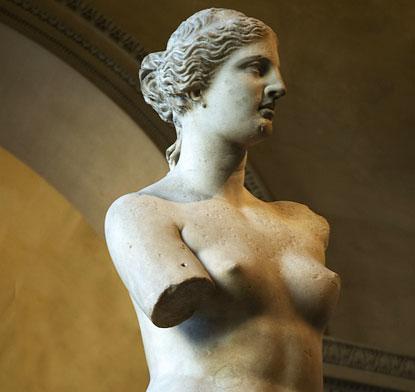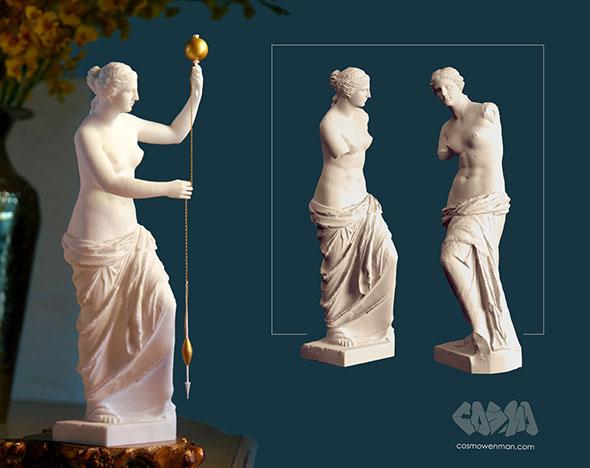 The Venus de Milo, an enigma carried down through the ages, has given us plenty to speculate about. Considering the imagery and scenarios that have been woven regarding the direction of her gaze—and arms—one might consider it better that it was left up to the imagination, as we have such a rich tapestry of proposals considering what she was doing.
The Venus de Milo, an enigma carried down through the ages, has given us plenty to speculate about. Considering the imagery and scenarios that have been woven regarding the direction of her gaze—and arms—one might consider it better that it was left up to the imagination, as we have such a rich tapestry of proposals considering what she was doing.
If you want to see her, it will take a trip to the grand city of Paris, as she is housed in the Louvre, permanently on display there. Although the much discussed statue was created circa 100 BCE, her name as we know it was created upon her discovery on the island of Milos. Found by a peasant who came upon ancient ruins in 1820, the Venus de Milo was found within, in two pieces, her arms missing. Since then, the placement of her limbs and hands has become the stuff that indeed legends are made of, with many storytellers and artists going to great lengths in theory.
With the general consensus being that there is no consensus, once again we’ve taken the matter of her gesture and attention into our hands, but armed with new technology. Writer Virginia Postrel, struck by the ongoing theme of the idea that the statue was perhaps sculpted to be engaged in the activity of spinning thread, decided it was worth checking it out in 3D.
First, she had to find a technical artist skilled in and worthy of recreating such a piece revered by the world. Enter one Cosmo Wenman, a San Diego designer and artist who is dedicated to the idea of museums and possessive entities allowing public access to 3D scans of famous artworks so that they can be transformed imaginatively. (It’s not such a far-fetched idea, and we’ve reported on it being done in small doses, in other museums overseas.)
Wenman is more than just a talented and engaged artist, as he is already somewhat famous for working on similar projects, including a previous 3D capture of Venus. But could he recreate her as a spinner? The idea that she would have been spinning thread prevailed as it would have been realistic during her time, and both the set of her body and direction of her gaze suggest it as a workable theory for the original artist’s work.

3D print of Venus de Milo Spinning Thread, left, and computer renderings of original 3D scan of Venus, missing her arms.
After several different tries, working with a digital anatomist, Wenman was able to make a 3D model which they then had 3D printed through Shapeways. The end product was a tabletop 3D printed model that suggested perhaps, just perhaps, she was indeed spinning thread. Theorizing on material brought him to an interesting conclusion, however.
“Maybe she lost her arms,” he quipped, “because some dope did, in fact, put a 30-pound marble ball on the top of the distaff, and 20 pounds of extra weight from a solid marble spindle hanging on her right arm.”
Choosing some more suitable materials for the tabletop piece, Wenman used lightweight painted wood for the tools and a gold chain for her thread, creating a stunning contrast against the white statue, catching our attention with such a stunning modern twist of color.
While multiple scholarly theories still clearly abound for what Venus de Milo was truly engaged in, as Postrel states, “…the replica demonstrates plausibility.”
We may see more of this idea where classic artworks are transformed, filling in missing limbs or body parts that have been missing for ages—or altogether changing things the way we see fit. While without permission or formal release of files, sometimes this type of artwork can send many into a flurry over intellectual property and copyright laws, no one can debate that with 3D scanning, digital design, and 3D printing, we can put a new spin on many of the classics. They obviously can’t be replaced, but it’s often provocative for the viewing public—which is the whole point of art, often—and generally pays homage to the original art piece no matter the public perspective.
What are your thoughts on missing limbs of the Venus de Milo? Does the 3D printed version sway you one way or the other? How do you think re-creation of classic artwork with 3D printing will be accepted over time? Discuss in the 3D Printed Venus de Milo forum thread over at 3DPB.com. Below is a look at the 3D render for Shapeways.
[Source: slate.com]
Subscribe to Our Email Newsletter
Stay up-to-date on all the latest news from the 3D printing industry and receive information and offers from third party vendors.
You May Also Like
Profiling a Construction 3D Printing Pioneer: US Army Corps of Engineers’ Megan Kreiger
The world of construction 3D printing is still so new that the true experts can probably be counted on two hands. Among them is Megan Kreiger, Portfolio Manager of Additive...
US Army Corps of Engineers Taps Lincoln Electric & Eaton for Largest 3D Printed US Civil Works Part
The Soo Locks sit on the US-Canadian border, enabling maritime travel between Lake Superior and Lake Huron, from which ships can reach the rest of the Great Lakes. Crafts carrying...
Construction 3D Printing CEO Reflects on Being Female in Construction
Natalie Wadley, CEO of ChangeMaker3D, could hear the words of her daughter sitting next to her resounding in her head. “Mum, MUM, you’ve won!” Wadley had just won the prestigious...
1Print to Commercialize 3D Printed Coastal Resilience Solutions
1Print, a company that specializes in deploying additive construction (AC) for infrastructure projects, has entered an agreement with the University of Miami (UM) to accelerate commercialization of the SEAHIVE shoreline...






























